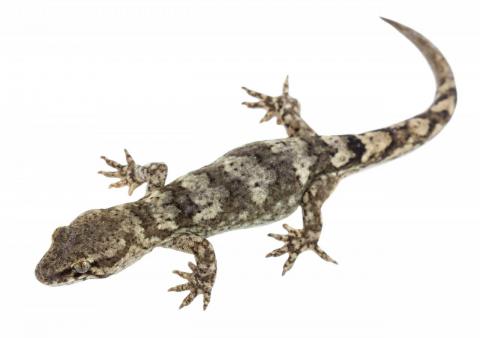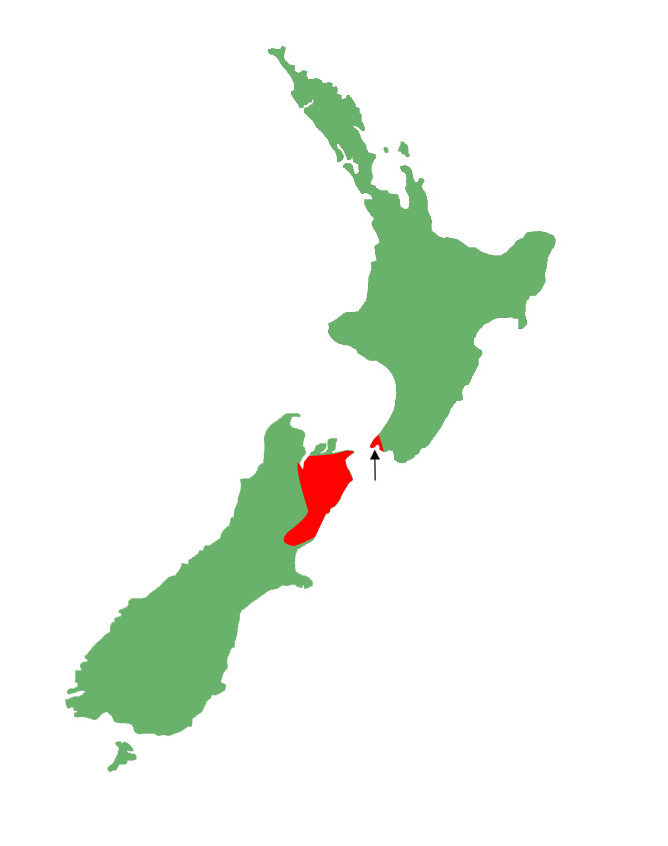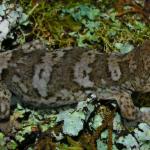- Home
- Herpetofauna Index
- Native
- Woodworthia "Marlborough Mini"
Woodworthia "Marlborough mini"
Minimac gecko
Woodworthia "Marlborough mini"

Length: SVL up to 65mm, with the tail being equal to the body length
Weight: unknown
Description
A small, and often beautifully patterned Woodworthia known from the north-eastern South Island, and Wellington regions. The species is characterised by its alternating light and dark markings on the dorsal surfaces, but may occasionally be almost uniform. The base colour is brown to grey, with the lighter brown to whitish-grey markings appearing as banding, or irregular / offset blotching. A dark stripe runs from the nostril through the eye onto the back of the neck. The sides of the animal are often the same brown to grey as the upper surfaces, and often have irregular grey or light brown blotching. The lower surfaces of the animal are often a uniform light-brown or grey colour, with or without light brown speckling.
There is some overlap between the Minimac gecko and several other Woodworthia species. They can be differentiated from the co-occurring Raukawa (Woodworthia maculata), Southern Alps (Woodworthia "Southern Alps"), and Waitaha geckos (Woodworthia cf. brunnea) by their smaller size and differences in colouration and patterning. Can be quite hard to differentiate from the closely related Pygmy (Woodworthia "pygmy"), and Kaikouras gecko (Woodworthia "Kaikouras"), but in general they are larger and have more contrasting markings than the former, and are smaller and have less contrasting markings than the latter.
Life expectancy
Unknown.
Distribution
Restricted to coastal, and non-forested regions of Marlborough, north-east Nelson, and northern Canterbury. A population is also present on the western coastline of Wellington.
Ecology and habitat
A nocturnal species, that is saxicolous and terrestrial. Found in a variety of habitats from the coast, where it inhabits boulder beach habitats, through to the alpine zone where it is associated with rocky habitats (screes, talus slopes, and rock outcrops). In the Wellington region, they are primarily restricted to coastal habitats.
Social structure
Can reach high densities in some habitats, but unlike other saxicolous Woodworthia species, they do not tend to congregate in large numbers within refuge sites.
Breeding biology
Viviparous (live-bearing). Up to two young born between February and March.
Diet
As with other members of the Woodworthia genus, Minimac geckos are omnivorous, feeding on a variety of invertebrates, as well as the nectar and fruit / berries of native plants.
Disease
Largely unknown.
Minimac geckos have been recorded with ectoparasitic mites in the wild.
Conservation strategy
The Minimac gecko is classed as a "Declining" species by DOC, with mammalian pests being a serious threat to them throughout their range. This species is not being actively managed.
Interesting notes
This species' common and TAG names both give reference to its small size and distribution. Minimac being a combination of mini and maculata (the specific name for the Raukawa gecko), identifying it a smaller member of the Woodworthia genus. Whereas the TAG name references its small size 'mini', and one of its strongholds - the Marlborough region.
Minimac geckos are members of the 'common gecko' complex, a group of closely related species which are regionally distributed throughout New Zealand. Historically, most of these were considered a single highly-variable species - Hoplodactylus maculatus (the so called 'common gecko'). The 'common gecko' has now been separated into over ten different species.
The Minimac gecko along with its sister species the Kaikoura's gecko sits within the Northern clade of the Woodworthia complex, with the pygmy gecko being their closest relative within the group.
References
Jewell, T. (2011). A photographic guide to reptiles and amphibians of New Zealand. Auckland: New Holland Publishing.
van Winkel, D., Baling, M. & Hitchmough, R. (2018). Reptiles and Amphibians of New Zealand: A field guide. Auckland: Auckland University Press, 376 pp.


